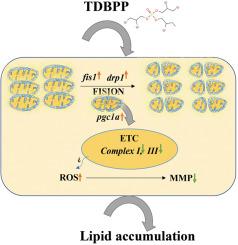Ecotoxicology and Environmental Safety ( IF 6.8 ) Pub Date : 2021-06-16 , DOI: 10.1016/j.ecoenv.2021.112425 Xiaochun Ma 1 , Dezhao Lu 1 , Ying Liu 1 , Yifei Le 1 , Hang Chen 1 , Xiaowen Li 2 , Cui Wang 1

|
The frequent detection of (2,3-dibromopropyl) phosphate (TDBPP) in environment has led to a consistent risk to organisms. However, little is known about the toxicity of TDBPP exclusive for its carcinogen. Mitochondrion that tightly relates to adverse outcomes once deteriorated is referred as a target of environmental pollutants. Here, we investigated the role of mitochondrial abnormality in development of cellular pathobiology especially lipid deposition when response to TDBPP in mitochondria-rich hepatocyte (AML12) at the same order of magnitude as the environmental concentrations (10−6 mol/L or below) via multiplexed quantitative high content analytic system. The present study claimed TDBPP shifted mitochondria from fusion morphology to fission phenotype charactering by less mitochondrial networks, larger mitochondrial areas and shorter branch length at 10−7 mol/L or above. This dynamic imbalance was triggered by high levels of fis and drp1 genes when treated with TDBPP. The deformation caused by TDBPP reciprocally influenced biogenesis through PGC1α and electron transport chains via ectopic expression of genes encoding for mitochondria complex I and III subunits. Accordingly, we observed high mitoROS level and low mitochondria membrane potential. Consequently, cells contained those abnormal mitochondria were predisposed to accumulating lipids after exposure to TDBPP. Here we showed that TDBPP deteriorated mitochondrial morphology and function, which may induce lipid generation. As for a banned while still emerged contaminant, our study also claimed further exploration on the non-carcinogenic toxicity of TDBPP.
中文翻译:

三(2,3-二溴丙基)磷酸酯对肝细胞线粒体毒性的多重定量评价
环境中频繁检测到(2,3-二溴丙基)磷酸酯 (TDBPP) 已导致对生物体的持续风险。然而,人们对 TDBPP 独有的致癌物的毒性知之甚少。一旦恶化,与不良结果密切相关的线粒体被称为环境污染物的目标。在这里,我们研究了线粒体异常在细胞病理生物学发展中的作用,尤其是在富含线粒体的肝细胞 (AML12) 中对 TDBPP 的反应与环境浓度 (10 -6mol/L 或以下)通过多重定量高含量分析系统。本研究声称 TDBPP 将线粒体从融合形态转变为裂变表型,其特征是线粒体网络较少,线粒体面积较大,分支长度较短,为 10 -7 mol/L 或以上。这种动态的不平衡是由高水平的触发FIS和DRP1时TDBPP治疗基因。TDBPP 引起的变形通过编码线粒体复合物 I和III的基因的异位表达,通过 PGC1α 和电子传递链相互影响生物发生亚基。因此,我们观察到高 mitoROS 水平和低线粒体膜电位。因此,含有异常线粒体的细胞在暴露于 TDBPP 后易于积累脂质。在这里,我们发现 TDBPP 使线粒体形态和功能恶化,这可能会诱导脂质生成。对于一种禁用但仍然存在的污染物,我们的研究还要求进一步探索 TDBPP 的非致癌毒性。



























 京公网安备 11010802027423号
京公网安备 11010802027423号